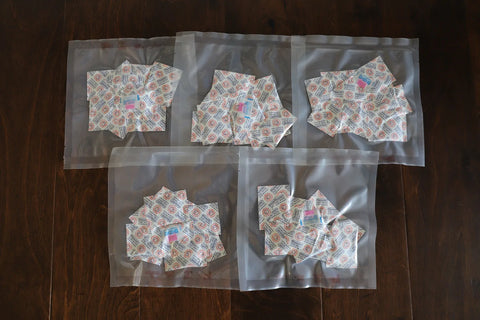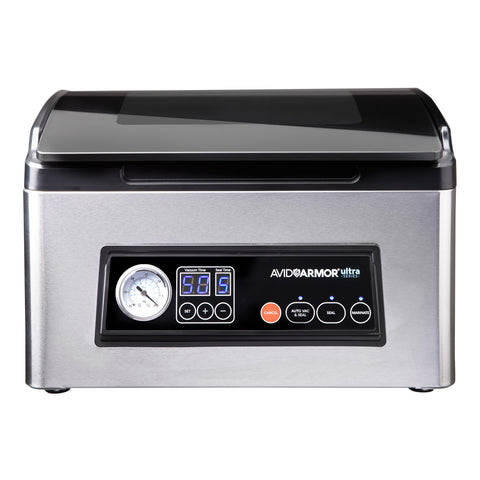Contributed By: Live. Life. Simple.
*The first thing you need to determine for food storage is the length of storage time desired. If you are only storing short term for personal use or giving freeze dried food as a gift, then the next sentence may not be as relevant to your situation. The 3 worst enemies of Freeze Dried food are: 1) light 2) moisture 3) oxygen
The reason these 3 things are so detrimental for food storage is because those 3 things are needed for bacteria to grow.
*If this is a product that you desire to reach maximum storage longevity, you will need to eliminate the following 3 things:
1) MOISTURE --- If you introduce any amount of moisture to your freeze dried food or the food you are trying to store is not an absolute “0” moisture level, the clock is ticking for end of shelf life. Also, be mindful of your storage location. Just because your food is dry immediately after freeze drying, a humid climate or damp basement can affect storage time. To ensure your best chances of having a “0” moisture level, keep reading below for additional practices.
2) LIGHT – Light can be avoided by storing your freeze dried food in Mylar bags followed by storage in an area that does not regularly receive any light (natural or man made). 5 mil and 7 mil Mylar bags are capable of blocking all or most light if they are true to their claimed specs. Keep in mind that ball jars will not block much, if any light (see more info below). Mylar bags are not all created equal and I encourage you to do your due diligence, especially before purchasing a large amount. At www.freezedryingsupplies.com we sell 5.5mil Mylar food grade bags that are created by a food bag manufacturer. We are not the thickest or the least expensive, but the bags are USA made and Made by a reputable food storage bag manufacturer.
3) OXYGEN --- The two most effective ways I have found to remove oxygen in large amounts and trace amounts are with oxygen absorbers and a chamber vacuum sealer that is capable of sealing thick Mylar bags. In most cases, a 300cc oxygen absorber is enough to eliminate a satisfactory amount of oxygen in the smallest Mylar bags all the way up to a 1 gallon size. Please consult the bag manufacturer especially if you are storing in a bag larger than 10 x14 or 1 gallon size. As for vacuum sealers, I have only found a handful that will remove a useful amount of oxygen, under vacuum, as well as sealing or double sealing the thickness of Mylar bag needed for long term food storage.
I prefer the Avid Armor USV32 and the Avid Armor ES41 Euro Series because they have the ability to do large size (10x14 or 1 gallon bags) and they can also DOUBLE seal the thickest 7 mil bags. There are other brands out there that are fully capable of doing these things, but for overall price vs. function and quality, these are the best in my opinion. If you would like to get 10% off a chamber vacuum sealer or any other products from AVID ARMOR, you can follow this link https://avidarmor.com?aff=43 and enter the code LIVELIFESIMPLE into the promo code area at checkout.
Rodents
Always keep in mind that rodents can be a huge factor in storage. I have heard on many unfortunate occasions that rodents have broken through containers or boxes and destroyed years worth of effort and food. Keep your freeze dried food off the ground in a rodent free environment or in a rodent proof storage container or box.
Ball/ Mason Jars
If you are using Ball/ Mason jars to store your food, your shelf life will be dramatically reduced due to the fact you are only eliminating moisture and oxygen. Ball jars, even if kept in a dark place, will allow light over time and you will see the food “fade” in color. Another factor to consider when storing in jars is the reliance on a lid seal. If the seal is not properly seated, defective or just has a very slow leak, you run the risk of adding another component of failure into storage.
How to get moisture free food
If you are not 100% certain that your freeze dried food is not free from moisture, oxygen and light, proceed with caution. Foods can look and smell alright, but may still be unsafe to eat. Always use your eyes and sense of touch as your first line of defense when it comes to whether or not your food is done. I also feel more confident when the trays removed after a cycle is complete are ALL warm to the touch. As a second line of defense, these things may help determine as well.
INFRARED THERMOMETER – The infrared thermometer is capable of finding cold spots in the center of foods, especially thick items. While there is no magic number you are looking for when using this, a dramatic drop in temperature (ie. one section of the tray reads 87 degrees and one section has readings of 42, there are most likely spots that are not fully sublimated (freeze dried). You can purchase the infrared thermometer by following this link https://amzn.to/3RBkSfy
FOOD SCALE – Weighing your food can be extremely helpful as well. If you are ever unsure if your food is not done after the cycle is complete, weigh your food and place it back into the freeze dryer for another 2 hours (or more). After that cycle is done, weigh your food again. If the weight is the same as the end of the last cycle, there is no additional water that can be removed. Therefore, your food is as dry as it can be. If the weight is less, repeat the time add process until the two weight readings are the same.
The food scale I use can be found by following this link https://amzn.to/3RyINwa
***All above statements are based on my personal experience, and do not necessarily reflect absolute results for the reader. As in every case in our freeze drying cookbook and freeze drying in general, results can vary greatly with varying climates, foods, drying times, products used etc. etc. etc.






Comments (0)
There are no comments for this article. Be the first one to leave a message!